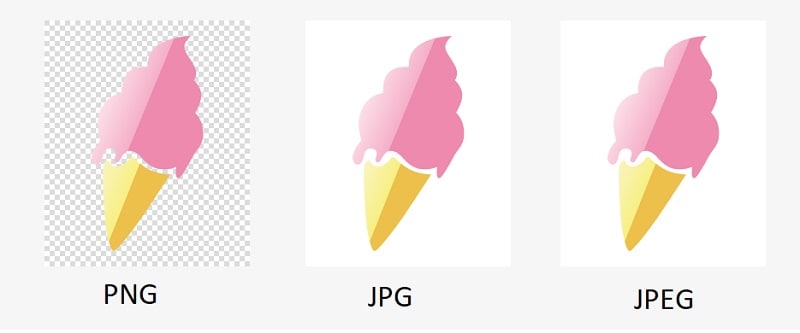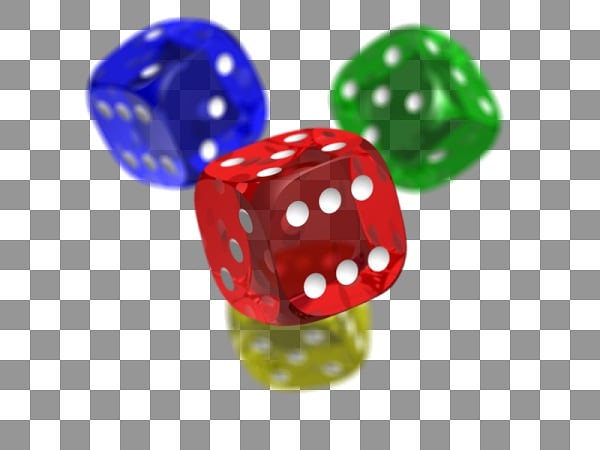What is the difference between PNG, JPG, or JPEG and how to pick the right format for image editing or transferring?
As a reader asked me this question recently, I realized that so many people find it hard to distinguish between these popular image formats. For instance, do you know that PNG is a preferred format for editing while JPEG is the most common image format for storing images? Here, I will provide a detailed difference between PNG, JPG, or JPEG, letting you pick the best image format for all kinds of applications.

Part 1: PNG, JPG, or JPEG: Whats the Key Difference
To start with our comparison of these popular image formats, lets get to know about their key features and limitations first.
PNG
PNG, which stands for Portable Networks Graphics, is a popular raster-based graphics format that is mostly used in image editing. PNG is a non-patented format that follows a lossless compression technique to maintains the overall quality of images.

Instead of compressing the whole image at once, PNG supports a pixel-to-pixel compression that retains the original image quality. Though, the biggest advantage of PNG is that it supports transparency. This means the background of PNG images can be transparent so that we can easily overlay them on any other image. If your png file get corrupted, our articles will help you tackle it.
The PNG format also has a few major variants such as APNG, PNG-8 (with 1-bit transparency and 256 colors), and PNG-24 (that supports 16 million colors).
Pros
Supports transparency in image backgrounds, making it ideal for editing and display.
PNG follows a lossless compression, maintaining the original quality of the image.
With PNG, you can easily add details about the metadata of the images or work on different layers.
Cons
PNG does not support native EXIF details.
The overall compression technique in PNG is not that great as the files size would be pretty large.
No support for animation.
JPG or JPEG
To continue with our PNG, JPG, or JPEG comparison, it is important to discuss the difference between JPG and JPEG.
Difference between JPG and JPEG
Ideally, both JPG and JPEG are the same formats and there is no difference between these image extensions. The format stands for Joint Photographic Experts Group and was initially released in 1992. At that time, Windows PC would only support file formats in three characters, and thus, JPEG was shortened to JPG to make it compatible with Windows. On the other hand, Mac and Linux systems kept using JPEG.
As of now, Windows, Mac, and several other systems use both JPEG and JPG interchangeably. You can even use JPE, JIF, JFI, and JFIF to format your images in the same file format.
About JPEG
JPEG, which stands for Joint Photographic Experts Group, is the most popular image format in the world. It follows a lossy compression technique that can compress your files to a 10:1 ratio. The format follows the discrete cosine transformation technique and is widely used to transfer, store, and post images on different platforms.
Since JPEG can store EXIF details, it is extensively used to capture images on phones and digital cameras. Furthermore, due to its excellent compression results, it has become a dominant format for social media, websites, and online portals.
Pros
JPEG is the most widely supported file format for every major device and platform.
It provides excellent compression results (up to 10:1 compression ratio).
JPEG has integrated support to EXIF information.
Cons
The quality of the image would be compromised (since it supports lossy compression).
It does not support transparency (like PNG).
PNG |
JPEG/JPG |
|
| What is it? | It stands for Portable Network Graphics and is a raster-based graphics format. | It stands Joint Photographic Experts Group and is popular format for images. |
| Compression Algorithm | Lossless compression | Lossy compression |
| Transparency | Image transparency is maintained | image transparency is not maintained |
| Image Size | Bigger | Smaller |
| Image Quality | Better | Inferior |
| Available colors | 16 million | 16 million |
| Common Extensions | PNG | JPEG or JPG |
| Best for | Editing, scaling, and web content | Storage, editing, image processing, and posting |
Further Reading:
1. Fix "Cannot Open JPG Files With Windows Photo Viewer".
2. RAW vs. JPEG vs. DNG.
3. Invalid JPEG Marker Type is Found.
Part 2: PNG, JPG, or JPEG: Which Format Should I Use?
As you can see from our PNG, JPG, or JPEG comparison that these image formats can be used in different ways. Therefore, I would suggest that in numerous instances, you can consider either PNG or JPEG, as per your requirements.
-
For Image Editing
Ideally, both PNG and JPEG formats are extensively used in image editing and are supported by several applications. Though, if you want to maintain the original quality of the image, then consider going with PNG formats for editing. If you want, you can always export the PNG image into a supported JPEG format later on.
-
For Storing your Photos
If you simply wish to store a lot of photos in limited space, then JPEG would be a preferred option. This is because PNG follows a lossless compression technique, and its images can consume a lot of space. On the other hand, JPEG can drastically compress images while making them smaller and saving your storage space.

-
For Image Printing
In image printing, we prefer images of higher quality so that their pixels wont be stretched or distorted. Thats why a format like PNG would be ideal for image printing. Though, if you have a JPEG image of high quality, then you can consider it for image printing as well.
-
For Websites
On websites and social media platforms, both PNG and JPEG formats are extensively used. PNG is mostly used to display logos, banners, and illustrations that need a transparent background. Apart from that, JPEG is a more acceptable format to display images on all kinds of websites and social media platforms.
-
For Image Transfer
Since JPEG images would consume far less space than PNG images and are of smaller sizes, they are recommended for image transfer. For instance, you can transfer more JPEG in less time compared to PNG. Nevertheless, if you want to maintain the quality of images in the transfer process, then you can go with the PNG format as well.
What to do if my photos corrupted after converting the photo format?
A: You may find that the photos may be corrupted or damaged after converting their format, then don't worry, try Wondershare - Photo Repair to restore the photo quality to perfect.

-
Repair damaged photos with all levels of corruption, such as grainy photos, dark photos, pixelated photos, faded photos, etc.
-
Repair images of diverse formats, such as JPG, JPEG, PNG, CR3, CR2, NEF, NRW, etc.
-
Repair critically damaged or corrupted photos available on SD cards, phones, cameras, USB flash drives, and more.
-
The "AI Image Upscaler" feature can enlarge the repaired photos to 2X, 4X, and 8X.
-
Intelligently restore old/scatched photo and colorize black and white photos with various AI effects.
-
Support Windows 11/10/8/7/Vista, Windows Server 2003/2008/2012/2016/2019/2022, and macOS 10.10~macOS 14.
Part 3: Troubleshooting Tips to Use PNG, JPG, or JPEG Images
Furthermore, to make the most of your PNG, JPG, or JPEG photos, you can consider following these suggestions:
Tip 1: Avoid Forceful Conversion
Firstly, try not to convert your pictures from one format to another forceful. If you are doing so, then make sure you use any reliable converting tool that wont corrupt your images in the process.
Tip 2: Use Compatible Editors
It has been observed that editors and other third-party tools often end up corrupting images if the format is not supported by them. Therefore, before you edit your photos, make sure that the editor supports the designated format.
Tip 3: What to Do If My PNG/JPEG Files Are Corrupted?
At times, while transferring, storing, or editing our images, they can get corrupted due to numerous reasons. In this case, you can consider using any reliable photo repairing tool like Wondershare Repairit.
The desktop application can help you repair PNG, JPG, JPEG, TIFF, GIF, and all the other kinds of images. To use it, you just have to load your corrupt images on Repairit and go through a click-through process. The application supports two different image repairing modes (quick and advanced) that can fix all kinds of issues with your images.
Besides that, you can also get a preview of the repaired images on the native interface of Repairit and save them wherever you like. You can consider keeping a tool like Repairit handy so that you can repair your corrupt images in a jiffy.
Time to Conclude
There you go! I'm sure that after reading our comparison on PNG, JPG, or JPEG, you would be able to differentiate these image formats too. Apart from comparing their compression techniques, formats, and other parameters, I have also explained their key usage. Since both JPEG and PNG are popular image formats, you can consider using them in different ways, as per your requirements. Though, if your images have been corrupted due to any reason, then you can use a tool like Wondershare Repairit to fix them instantly.
FAQs
-
How do you save a photo as a JPEG file?
In most cases, JPEG is the native image format for saving photos. If your image is of any other format, then you can simply convert it to JPEG. The simplest way to do that is by opening it on MS Paint and saving it as a JPEG file. -
Whats the highest quality image format?
Mostly, image formats that follow lossless data compression techniques are considered superior as they retain the quality of the image. Some of these effective lossless image formats are TIFF, PNG, RAW, and BMP. -
Is JPG the same as JPEG?
Yes, both JPG and JPEG are essentially the same image formats. The only difference is that the container (format name) used by them is different. JPG is simply the shorter version of JPEG that was derived to support it on Windows PC.


 ChatGPT
ChatGPT
 Perplexity
Perplexity
 Google AI Mode
Google AI Mode
 Grok
Grok
